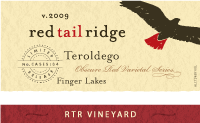By Evan Dawson, Finger Lakes and Managing Editor
 Visitors to Red Tail Ridge Winery on Seneca Lake have to weave through the vineyards to reach the tasting room, and lately they might have noticed something unusual. The signs at the end of the rows have taken on a rather offbeat edge, marking the home of grape varieties that many customers have never encountered.
Visitors to Red Tail Ridge Winery on Seneca Lake have to weave through the vineyards to reach the tasting room, and lately they might have noticed something unusual. The signs at the end of the rows have taken on a rather offbeat edge, marking the home of grape varieties that many customers have never encountered.
Few can even pronounce Teroldego.
"We didn't start this winery to be a mainstream producer," Nancy Irelan, owner and winemaker, explained during a recent visit. "There's a part of Red Tail Ridge that will always experiment. We'll always have a component that's research-based."
Irelan is a longtime viticultural researcher, working in California for Gallo, and she's built a long resume of research and consulting projects. When she arrived in the Finger Lakes six years ago, she didn't leave the thirst for understanding on the west coast. Her desire to find the most suitable red grape varieties for the Finger Lakes has culminated in the launch of Red Tail Ridge's new "Obscure Varietal Series." It will include Teroldego (prounounced "teh-RAHL-de-go"), along with Blaufrankisch (you might know it as lemberger) and Dornfelder. Eventually, Irelan can envision planting even more unusual varieties, but she's not ready to reveal yet what those will be.
But why, I wondered, is Irelan investing so much time and attention to a line of wines that will comprise roughly eight percent of Red Tail Ridge's production?
 "Because it's personal," she said, stern-faced. Then she broke into a wide smile. "Because it's fun! We feel that some customers will appreciate it."
"Because it's personal," she said, stern-faced. Then she broke into a wide smile. "Because it's fun! We feel that some customers will appreciate it."
Irelan's desire to educate wine consumers runs counter to the view of some of her colleagues, who might find it too difficult to convince customers to try these exotic-sounding wines. Yes, the world knows chardonnay and cabernet sauvignon, merlot or even grenache. Why start over with a wine like teroldego?
But Irelan does not find the challenge too tall. When it comes to white wine, Irelan is easily convinced of riesling's regional majesty; it forms the bulk of Red Tail Ridge's production. But on the red side, Irelan believes many more years of research are necessary before she can make any firm pronouncements.
This approach has impressed her neighbors. Johannes Reinhardt, winemaker at nearby Anthony Road Wine Company, recently said, "Nancy and Mike (Irelan's husband) are quickly becoming leaders. They're going to ring the bell for a long time, just wait and see."
It's also worth pointing out that Irelan has the luxury of making viticultural guesses that are more laser beams than shots in the dark. She has seen how grapes behave in a wide range of climates and soil bases.
"If we're going to take risks, we better do our homework," Irelan said. "We're a business and I'm married to an MBA."
That means each new variety receives only a small initial planting, with room to expand if the grape shows a track record of strong wines. Expect this lineup to expand, with the Dornfelder coming out around the holidays. Here are the wines we tasted on my visit.
(34 cases) This is a still red wine; some customers will note that Irelan made a sparkling teroldego in a previous vintage. That sparkler was such a surprise hit with customers that Irelan is considering keeping it in the lineup, but she's strongly focused on making a varietal teroldego that will show the depth of the grape.
This wine is smoky and interesting, showing a kind of side that Irelan describes as "brooding." Teroldego is a big, thick-skinned grape that hangs in loose clusters, allowing it to avoid disease easily. The result (also thanks to the outstanding growing efforts of Mike Schnelle) is a wine that is showing some complexity at a young age. The tannins are present but soft; the wine is brambly and spicy. There's not much of it, yet.
(409 cases) For now, Irelan uses fruit from the Martini Family vineyard down the road, but Red Tail Ridge will soon have its own plantings. This version calls to mind many other Finger Lakes lembergers. Think raspberry cream, anise, a little campfire from the American oak that is only 11% new.
Regarding why she decided to go with the grape's traditional old-world name, Irelan said, "It's blaufrankisch. Why not just call it what it is? We want to keep the most commonly understood names for these wines."
2010 Teroldego (from barrel)
(90 cases) By any measure, this is the best wine of the group, and I rarely make such a statement about a wine tasted from barrel. But there is complexity and personality in this wine that stands above the other wines we tasted. That spicy note has turned into a finishing kick of capicolla, and the tannins are riper, offering more structure. I don't know where this wine will finish, but it's already arrived at a fascinating place.
2010 Blaufrankisch (from barrel)
(500 cases) Has the imprint of a long, warm growing season. This wine is similar to the 2009, but simply amplified and more complex. It seems to be wearing the oak well.


